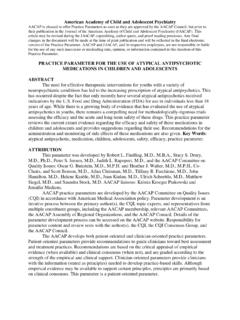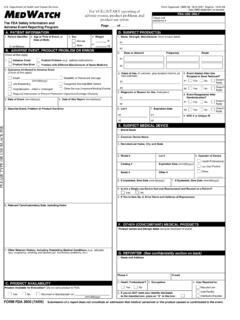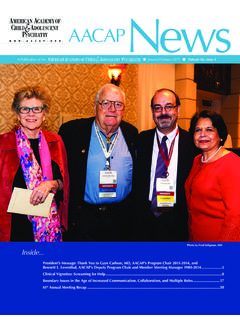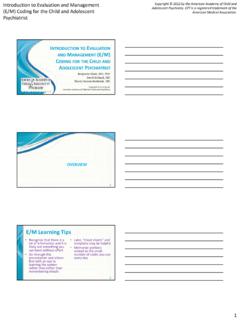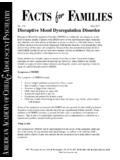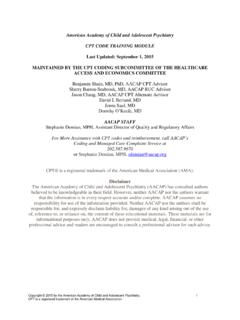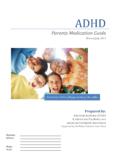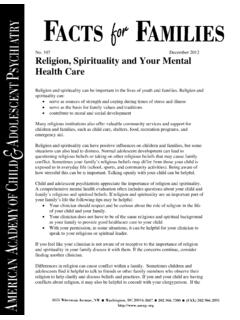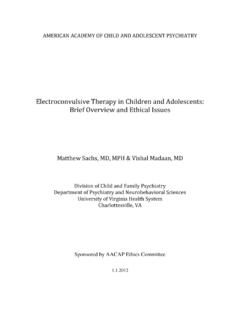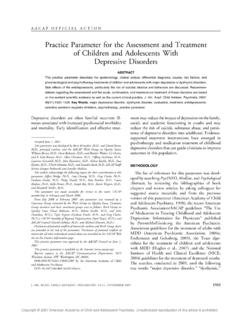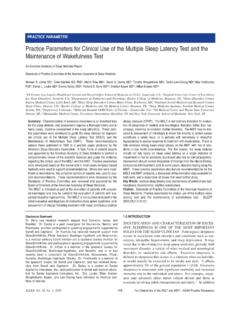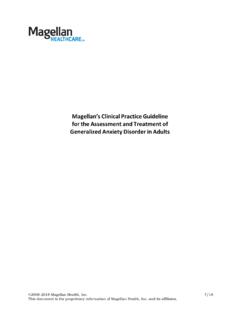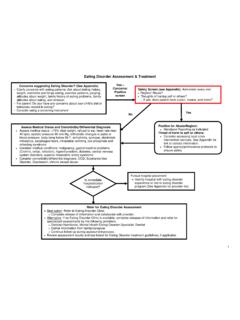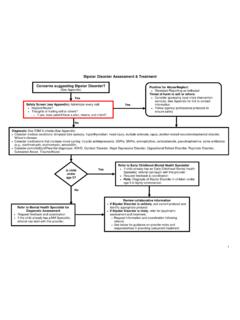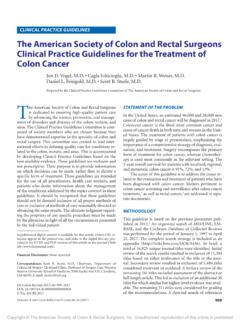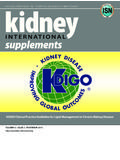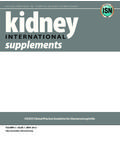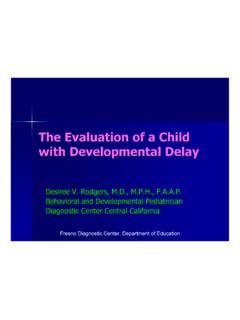Transcription of Practice Parameter for the Assessment and Treatment of ...
1 AACAP OFFICIAL ACTION. Practice Parameter for the Assessment and Treatment of Children and Adolescents With Attention-Deficit/. Hyperactivity Disorder ABSTRACT. This Practice Parameter describes the Assessment and Treatment of children and adolescents with attention-deficit/. hyperactivity disorder (ADHD) based on the current scientific evidence and clinical consensus of experts in the field. This Parameter discusses the clinical evaluation for ADHD, comorbid conditions associated with ADHD, research on the etiology of the disorder, and psychopharmacological and psychosocial interventions for ADHD.
2 J. Am. Acad. Child Adolesc. Psychiatry, 2007;46(7):894Y921. Key Words: attention-deficit/hyperactivity disorder, evaluation, Treatment , Practice Parameter . Attention-deficit/hyperactivity disorder (ADHD; seek to lay out evidence-based guidelines for the American Psychiatric Association, 2000) is one of the effective diagnosis and Treatment of ADHD. most common childhood psychiatric conditions. It has In this Parameter , the term preschoolers refers to been the focus of a great deal of scientific and clinical children ages 3 through 5 years, the term children refers study during the past century.
3 Upon reviewing the to children ages 6 through 12 years, and the term voluminous literature on ADHD, the American adolescents refers to minors ages 13 through 17 years. Medical Association's Council on Scientific Affairs Parent refers to parent or legal guardian. Patient refers (Goldman et al., 1998) commented, BOverall, ADHD to any minor with ADHD. The terminology in this is one of the best-researched disorders in medicine, and Practice Parameter is consistent with that of DSM-IV- the overall data on its validity are far more compelling TR (American Psychiatric Association, 2000).
4 Than for many medical conditions.^ Although scientists and clinicians debate the best way to diagnose and treat METHODOLOGY. ADHD, there is no debate among competent and well- informed health care professionals that ADHD is a The list of references for this Parameter was valid neurobiological condition that causes significant developed by searching PsycINFO, Medline, and impairment in those whom it afflicts. These guidelines Psychological Abstracts; by reviewing the bibliographies Accepted February 18, 2007.
5 Group members and their constituent groups were as follows: Work Group on This Parameter was developed by Steven Pliszka, , principal author, and Quality Issues (Oscar Bukstein, , Allan Chrisman, , R. Scott Benson, the AACAP Work Group on Quality Issues: William Bernet, , Oscar , and John Hamilton, ), Topic Experts (Larry Greenhill, , Bukstein, , and Heather J. Walter, , Co-Chairs; Valerie Arnold, , and Russell Barkley, ), AACAP Work Group on Research (Larry Greenhill, Joseph Beitchman, , R. Scott Benson, , Allan Chrisman, , Tiffany ), AACAP Assembly of Regional Organizations (Joan Gerring, , and Farchione, , John Hamilton, , Helene Keable, , Joan Kinlan, Guy Palmes, ), and AACAP Council (Cynthia W.)
6 Santos, , and , Jon McClellan, , David Rue, , Ulrich Schoettle, , Jon A. Catherine Jaselskis, ). Shaw, , and Saundra Stock, AACAP Staff: Kristin Kroeger Ptakowski Disclosures of potential conflicts of interest for authors and Work Group chairs and Jennifer Medicus. are provided at the end of the Parameter . Disclosures of potential conflicts of The authors acknowledge the following experts for their contributions to this interest for all other individuals named above are provided on the AACAP Web Parameter : Larry Greenhill, , Timothy Wilens, , Thomas Spencer, , site on the Practice Information page.
7 Joe Biederman, , Mina Dulcan, , Lily Hechtman, , Paul This Practice Parameter was approved by the AACAP Council on October 18, Hammerness, , John Hamilton, , Caryn Carlson, , Gregory 2006. Fabiano, , William Pelham, , James Swanson, , and Daniel This Practice Parameter is available on the Internet ( ). Waschbusch, Reprint requests to the AACAP Communications Department, 3615 Wisconsin This Parameter was reviewed at the Member Forum at the Annual Meeting of Avenue NW, Washington, DC 20016. the AACAP in October 2005.
8 0890-8567/07/4607-0894 2007 by the American Academy of Child and From July 2006 to September 2006, this Parameter was reviewed by a Adolescent Psychiatry. Consensus Group convened by the Work Group on Quality Issues. Consensus DOI: 894 J. AM. ACAD. CHILD ADOLESC. PSYCHIATRY, 46:7, JULY 2007. Copyright @ 2007 American Academy of Child and Adolescent Psychiatry. Unauthorized reproduction of this article is prohibited. Assessment AND Treatment OF ADHD. of book chapters and review articles; by asking col- with ADHD will continue to meet criteria for the leagues for suggested source materials; and from the disorder during their teenage years (Barkley et al.)
9 , previous version of this Parameter . The searches were 1990; Biederman et al., 1996; Claude and Firestone, conducted from September 2004 through April 2006 1995), clearly establishing that ADHD does not remit for articles in English using the key word Battention- with the onset of puberty alone. Defining the number deficit/hyperactivity disorder.^ The search covered the of children with ADHD who continue to have period 1996 to 2006 and yielded approximately 5,000 problems as adults is more difficult because of references.
10 Recent authoritative reviews of literature, as methodological issues reviewed by Barkley (2002). well as recent Treatment studies that were in press or These include changes in informant (parent versus presented at scientific meetings in the past 2 to 3 years, child), use of different instruments to diagnose were given priority for inclusion. The titles and abstracts ADHD in adults, comorbidity of the other psychia- of the remaining references were reviewed for particular tric disorders in the childhood sample (less comorbid relevance and selected for inclusion when the reference samples have better outcome), and issues with the appeared to inform the field on the diagnosis and/or DSM-IV diagnostic criteria themselves.
